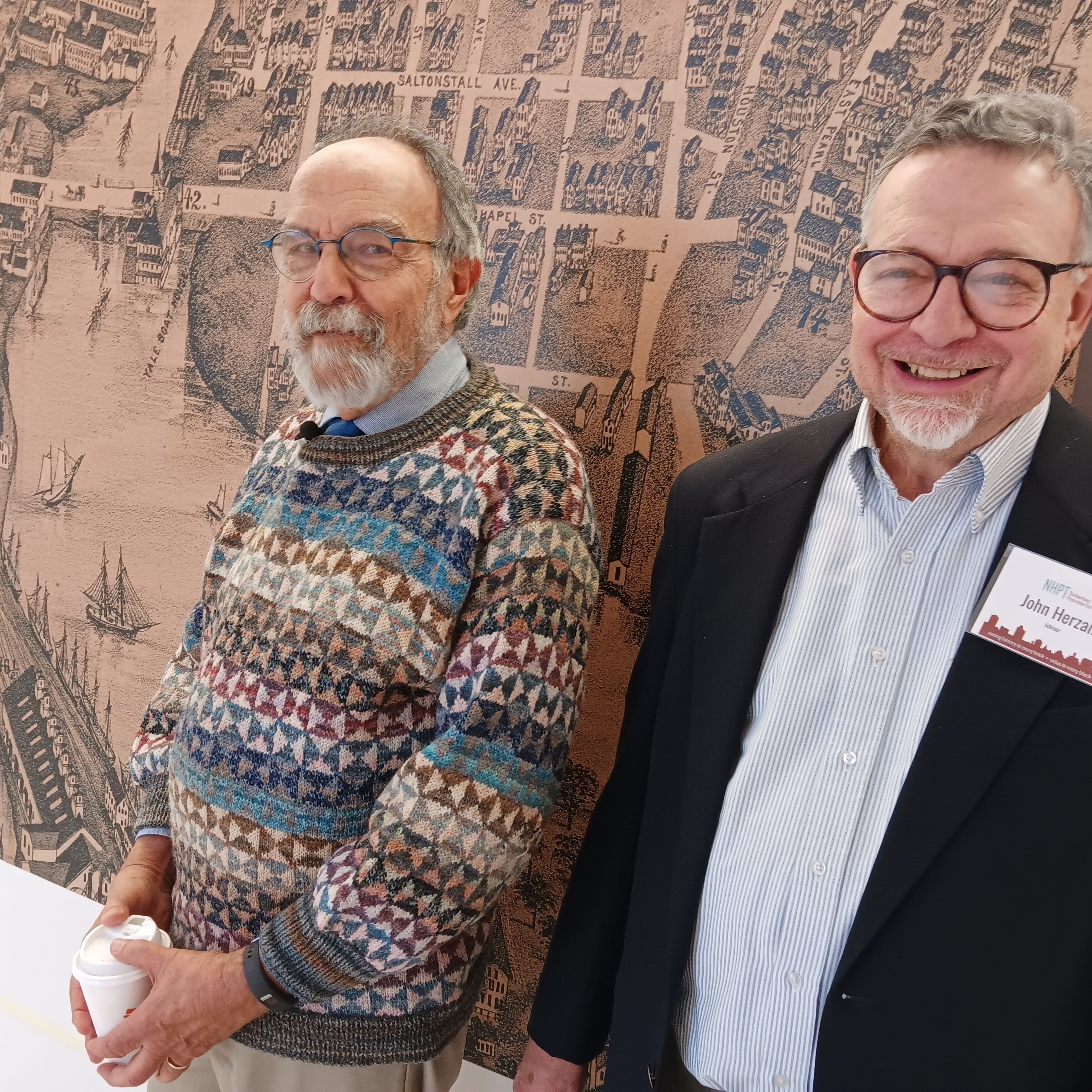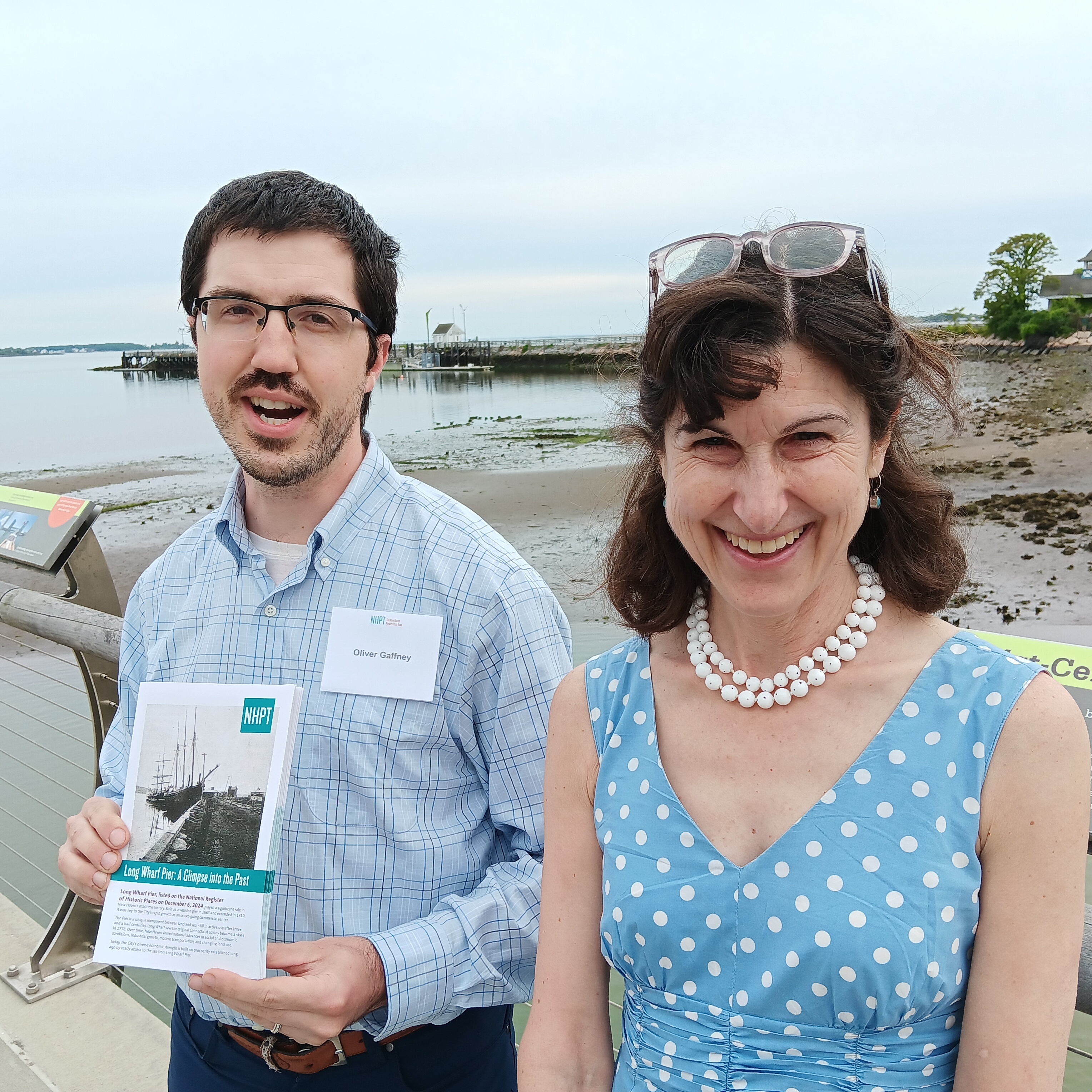
Allan Appel Photo
Mike Piscitelli receives plaque from NHPT Board Member Oliver Gaffney and NHPT Prez Charlotte Rea.
Susan Godshall explains Long Wharf Pier's national-historic nomination.
Nearly 200 preservation-minded New Haveners traveled to the Canal Dock Boathouse Tuesday night to celebrate the recent placement of the Long Wharf Pier on the National Register of Historic Places.
The New Haven Preservation Trust (NHPT), which was the formal applicant for the lengthy and rigorous two-year nomination process, presented a bronze plaque to city Economic Development Administrator Mike Piscitelli, to enthusiastic applause.
“This is a momentous occasion,” Piscitelli said. “We draw inspiration from the physical marvel [of the pier] and the cultural equity” it represents.
By cultural equity, Piscitelli was referring to William Lanson, an African American stonemason/engineer/entrepreneur and community leader, who, beginning in 1810, accomplished the feat of extending the pier 1,500 feet to allow ocean-going vessels to offload efficiently.
That was a huge factor in making New Haven the commercial powerhouse it became in the first half of the 19th century.
He overcame the racism of the period and the jealousy of white firms to supply the stones from up on East Rock, from his own quarry.
He used them to replace the traditional wood structures that were decaying and unable to stand up to the tides and built a structure, some of whose stones were still visible Tuesday, as it was low tide, across a stretch of the harbor as seen out the floor-to-ceiling windows of the Boathouse where the celebration was held.
NHPT President Charlotte Rea gave a special shout-out to Susan Godshall (who was unable to attend). She’s a former and long-time board member and now assistant treasurer of NHPT, and also a member of the city’s Historic District Commission.
Rea credited Godshall for being the lead shepherd for the application which, with maps, research, surveys, and other scientific evidence, demonstrated Long Wharf pier’s and Lanson’s contribution to engineering and maritime history, as well as to the social and ethnic development of New Haven.

Historian Bruce Clouette, with NHPT's John Herzan.
Piscitelli also praised Godshall as a mentor to city staff and a guiding light who kept telling, or yelling, at them, “Don’t tear everything down.”
The centerpiece of the evening was a lecture by long-time Connecticut historian of bridges, industrial sites, and local engineering marvels Bruce Clouette.
“The remnant of the pier is a mirror for centuries of New Haven history,” he said.
Clouette ought to know. In 2008, he was staff historian of a firm that was hired by the state Department of Transportation as it did work to improve I‑95.
The highway wasn’t improved much, he quipped, “but I recommended Long Wharf be considered a vital historic resource.”
That report was the beginning of the process that led to the formal designation, which was celebrated on Tuesday.
Clouette concluded his low-key, deeply informed, and often humorous remarks with a focus less on the pier than on the pier builder, Lanson.
He was no one-hit wonder, Clouette said, as after Long Wharf, he built a smaller structure, a kind of dock and dam nearby where boats moving along the Farmington Canal entered the harbor, thus opening up the products of the interior of the country to New Haven merchants, just as the Long Wharf brought the goods of the world to us.
Lanson, a committed integrationist unusual in his era, also led a drive to allow Blacks to vote (it failed); he helped to found what has become the Dixwell Avenue Congregational Church, and he was elected the leader, or as the word of the era had it, “governor,” of the “Negroes in New Haven.”
When health issues led Lanson to shift from the construction business, he became a landlord and then in a section of town near Wooster Square, then called New Liberia, he built a hotel.
At the hotel he insisted on serving both Black and white clients. For that he was economically profiled by competitors, harassed by the authorities, and ultimately this highly successful early African American entrepreneur and enlightened civic leader died in poverty.
During the brief question-and-answer period, someone queried if Clouette had found living Lanson relatives.
Clouette shook his and asked if audience members knew of any. No hand was raised.
“Then,” he concluded, “we all have to be his descendants to fight for preservation.”
Earlier in the day a formal press conference announcing the historic-place designation was held with city, state, and preservation officials. The designation at this time is especially significant, city officials said, as plans are evolving to spend millions to reconfigure Long Wharf Park and to re-develop the area.
The NHPT received a grant from the state Department of Economic and Community Development to facilitate the nomination process.
The formal listing of Long Wharf on the U.S. Department of the Interior’s National Register of Historic Places occurred on Dec. 6, 2024.

NHPT Board members Oliver Gaffney and Abby Roth, with some of the original Lanson stones visible, with low tide, in the distance.